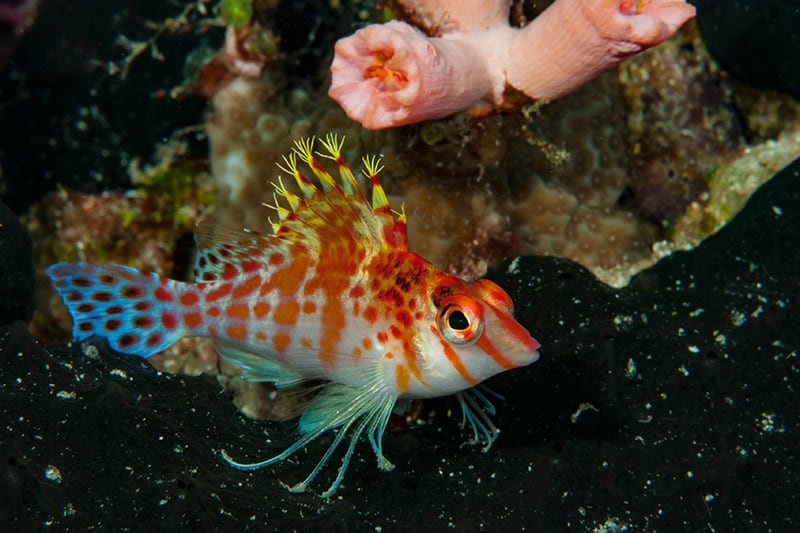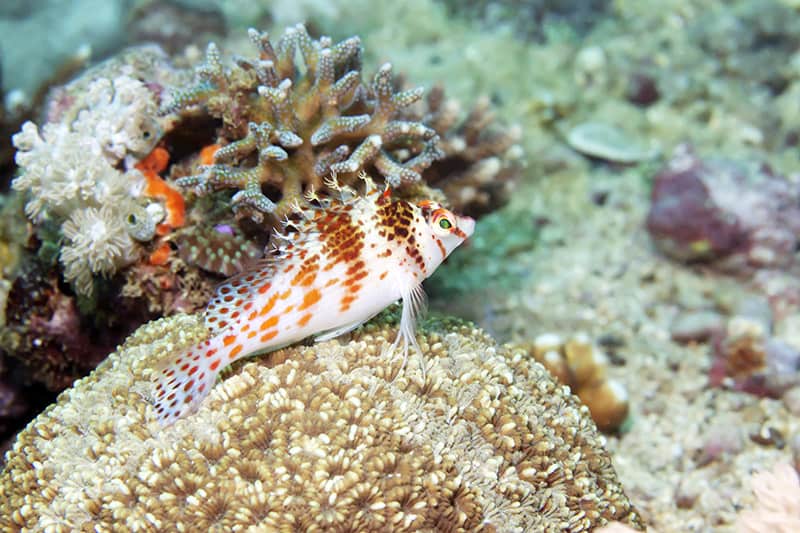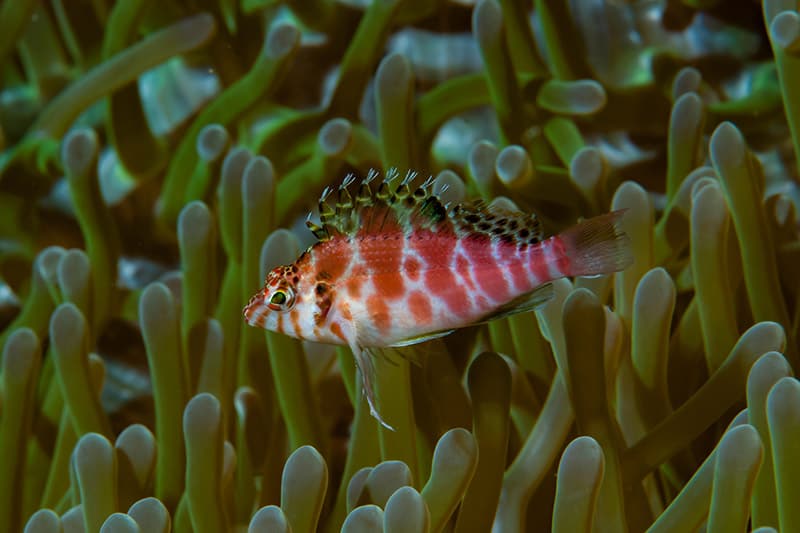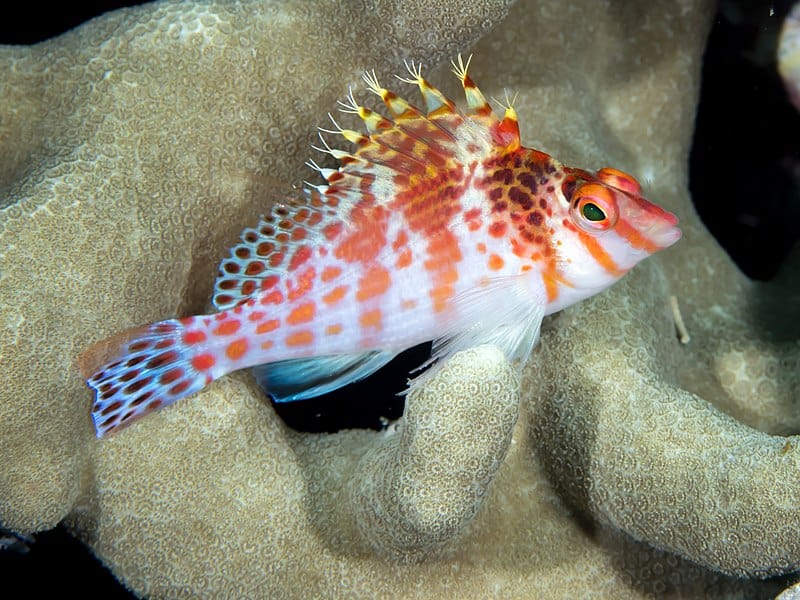Tons of personality packed into a pint size package, the Falco’s Hawkfish is great for a nano tank and just as at home in a large aquarium.
Falco’s Hawkfish have the similar “hump back” shape as their other large cousins, in dwarfed size. They are white overall with red to reddish brown spotting mostly on the top part of the fish. There are a few vertical bars that are “V” shaped, reaching down to just above the belly area. These bars are not solid in color, but consist of multiple different sized and shaped spots. The face has a narrow bar on the top of the head between the eyes to the tip of the nose and 2 more on each side of the face, under the eyes. The tips of most of the dorsal fin rays have yellow cirri, or hair like tufts, and the back part of the dorsal and the tail fins are opaque with more of the same color spotting. Their pectoral fins are large, and are used to perch on most of the time, due to their lack of a swim bladder. This is one of those bullet proof beginner fish and are very easy to care for.
The Falco’s Hawkfish have been known to spawn with the Spotted Hawkfish (C. aprinus) in the wild. Falco’s have a distinct look, and the only other fish that they may be confused with is the Pixi or Coral Hawkfish (C. oxycephalus), since it is the only other one in this genus that is of similar size. The Coral Hawkfish does not have the distinctive bars, so it has much less solid white in the body and does not have two thin bars under the eyes. The spotting of the Coral Hawkfish is also a little more uniform. Hawkfish are so named due to their hunting habits, which are characteristic of actual Hawks! They will perch and wait for prey; then, once dinner is spotted, they swoop down instantly, grab it, and then rush quickly back to their perch! Falco’s also like to watch their humans walk by, or will stare at them as they sit quietly reading a book!
The Falco’s Hawkfish are very easy to care for, and will accept most aquarium foods. Feeding them raw salmon for the natural red pigment will assist in helping them keep their bright reddish coloring. They also enjoy minced raw shrimp and fish flesh, so experiment with different types. They will eat flake and pellet, but this should be done sparingly and should have color enhancing properties. Freeze dried meaty foods will be accepted, but too much will cause your hawkfish to eventually refuse this food. Kind of like someone eating beef jerky all the time, yeah it would get old! Using a lid is advised.
The Falco’s Hawkfish should not be housed with peaceful fish such as small gobies, dartfish, flasher wrasses, small peaceful razor wrasses, or small anthias, as these will be victims of abuse, especially in smaller tanks. In larger tanks, over 100 gallons these fish may be attempted but the Falco’s Hawkfish should be added last. They get along with semi-aggressive fish and overly aggressive fish should be avoided, unless tank is much larger. Avoid housing with fish that will swallow them whole! They can be kept as a pair in a 40 to 45 gallon tank and a harem may be attempted with one male and 2 or 3 females in a tank that is 6 feet long to provide females with enough territory to defend. Avoid any peaceful substrate dwellers in such a tank. One of the following hawkfish may be attempted with the Falco’s Hawkfish in a large tank: Longnose Hawkfish, Lyretail Hawkfish or the Flame Hawkfish. Add the Falco’s before one of these hawkfish, allow it to acclimate for a month, then add the second hawkfish, but watch for aggression. While a well fed Falco’s Hawkfish shouldn’t bother larger shrimp, sexy shrimp and those of similar size will be eaten.
The minimum tank size is 15 gallons (57 liters), yet in such a small tank, the Falco’s Hawkfish should be the only fish due to their territorial nature. Add other fish with extreme caution. Larger tanks will allow for more tank mates. Provide areas within the live rock for hiding and hunting. Substrate, light, and water movement are all up to the aquarist, and the Falco’s Hawkfish is not too picky about any of that. They are typically found perching higher in the tank, and will just as often visit the substrate. Males with harems will choose to stay below or at the bottom of the tank rather than over the females.
- For more information on keeping this fish see: Guide to a Happy, Healthy Marine Aquarium
Scientific Classification
| Kingdom: | Animalia |
| Phylum: | Chordata |
| Class: | Actinopterygii |
| Order: | Perciformes |
| Family: | Cirrhitidae |
| Genus: | Cirrhitichthys |
| Species: | falco |
Falco Hawkfish – Quick Aquarium Care
| Aquarist Experience Level: | Beginner |
| Aquarium Hardiness: | Very Hardy |
| Minimum Tank Size: | 15 gal (57 L) |
| Size of fish – inches: | 2.7 inches (6.86 cm) |
| Temperament: | Semi-aggressive |
| Temperature: | 72.0 to 81.0° F (22.2 to 27.2° C) |
| Range ph: | 8.1-8.4 |
| Diet Type: | Carnivore |

Habitat: Distribution / Background
The Falco’s Hawkfish, Cirrhitichthys falco, was first described by Randall in 1963. The common names they have been called are Falco’s Hawkfish, Coral Hawkfish, Mottled Hawkfish, and Dwarf Hawkfish; which all describe their size and coloring. There are currently 36 species known to ichthyologists.
Falco’s Hawkfish are found in the Indo-pacific; from Maldives to Samoa, then northward to the Ryukyu Islands and then south to the southern part of the Great Barrier Reef and New Caledonia. They inhabit coral reefs that are in shallower coastal waters and outer reef slopes and flats from 15 to 151 feet ( 4 to 46 m). Typically they are located at the bases of coral heads feeding on copepods, other benthic crustaceans and very tiny fish that fit into their mouths.
They are found mostly in harems of one male who covers the territories of 2 to 7 females. Males with harems tend to perch below the females as opposed to above in some instances. The females will allow small juveniles to join them in their individual territories. Larger juveniles are found alone. Falco’s Hawkfish, as adults are sometimes found in pairs if the female population is too low, or even solitary. In the wild, Falco’s Hawkfish has been known to spawn with the Spotted Hawkfish (Cirrhitchthys aprinus).
Falco’s Hawkfish are not on the IUCN Red List for endangered species.
Species Variations and Similar Species:
The Falco’s Hawkfish is one of a few smaller “dwarf” sized hawkfish with similar body shapes that range from 2.7” to 5.5.” The only other known species similar in size to the Falco’s Hawkfish is the Pixy or Coral Hawkfish.
- Pixy/Coral Hawkfish (C. oxycephalus): This hawkfish is slightly bigger, reaching 3.3” and both are whitish with orangish to tan spotting. The Coral Hawkfish has much more evenly spaced and larger spotting, and do not have 2 thin bars under each eye.
- Scientific Name: Cirrhitichthys falco
- Social Grouping: Varies – Can be found in small harems, pairs, or solitary
- IUCN Red List: NE – Not Evaluated or not listed
Description
The Falco’s Hawkfish is a small, yet deep bodied fish with a much deeper mid-body, giving the appearance of a “hump” on the back. The overall color is white with red to reddish brown spotting on the upper back, forming 5 vertical bars. The first two are very pronounced with darker reddish to reddish brown coloring, and are located just behind the head area and then the middle of the back. The last 3 are less defined and tend to be lighter as they approach the tailfin. The bars are wider at the dorsal area and then narrow and end before the “V” shaped bar reaches the belly. These bars are not solid in color, but consist of many smaller and differently shaped spots. The coloring of different specimens depends on their locations. Those found in sandy areas are lighter (red spotting with some yellow coloring behind the spots), and specimens living near stony corals have darker coloring (reddish brown spotting). The face has several stripes or thin reddish brown bars. One thin bar runs from between the eyes to the tip of the nose, then 2 more small thin bars that run from the middle of the eye to the mouth and from behind the eye to the chin. There is one dorsal fin, with the first 10 rays having cirri on the tip of each. Cirri are hairlike filaments at the tips of dorsal fin rays, and those are typically yellow to gold. The back half of the dorsal fin does not have the cirri and is opaque with reddish brown spotting. The tail fin is opaque with reddish brown spotting as well, and the pectoral fins are especially large and white to clearish, being primarily used to perch on. Their anal fins is whitish to opaque. There are also cirri behind the 2 nostril openings and their eyes are close together and near the top of the head, typical of predatorial fish. Hawkfish do not have swim bladders, though they can swim from perch to perch, but need to rest after a short time. Males are slightly larger, ranging from 2.1” to a possible 3.1” and females grow to 1.4” to 2.3” in length and can live 5 to 10 years.
- Size of fish – inches: 2.7 inches (6.86 cm) – Males are 2.1” to 3.1” and females 1.4” to 2.3” as adults.
- Lifespan: 5 years – May live up to 10 years with proper care
Fish Keeping Difficulty
Falco’s Hawkfish are quite easy to care for. They are very hardy, being one of the best beginner fish out there! They can be kept with other fish that are slightly cranky like they are, but do not house with overly aggressive fish in a smaller tank. Offer various types of minced up meaty foods, like shrimp and include raw salmon flesh, which provides the natural red pigment for their red coloring, since some lose color in captivity over time. They need crevices and caves to hide in when they feel threatened. Do not keep larger hawkfish with the Falco’s, since they will be attacked due to their very small size.
- Aquarium Hardiness: Very Hardy
- Aquarist Experience Level: Beginner
Foods and Feeding
The Falco’s Hawkfish is a carnivore, and should be fed a variety of meaty foods. Raw salmon flesh is a great source of natural red pigment, which can help prevent the hawkfish’s red color from fading in captivity. Feed finely chopped seafood flesh according to their size, including shrimp, crabs, frozen/thawed mysis shrimp, fortified brine shrimp, and finely chopped fish. You may occasionally feed them flake or pellets that have color enhancers. Do not feed them an exclusive diet of freeze dried meaty foods. Feed several times a day as juveniles and twice a day once they are full grown adults.
- Diet Type: Carnivore
- Flake Food: Occasionally – Only with color enhancing properties
- Tablet / Pellet: Occasionally – Only with color enhancing properties
- Live foods (fishes, shrimps, worms): Some of Diet – Not necessary, but a small hermit crab or two would be a treat.
- Meaty Food: All of Diet
- Feeding Frequency: Several feedings per day – Can feed twice daily as adults, more often as juveniles.

Shutterstock
Aquarium Care
Reef tanks
- Nano/Small tanks up to 40 gallons, perform 5% water changes weekly.
- Medium sized up to 90 gallons, perform 15% bi-weekly.
- Large Tanks 100 gallons and over, once water is aged and stable can be changed 10% bi-weekly to 20% monthly, depending on bioload.
Fish only tanks:
- Nano/Small tanks up to 40 gallons, perform 15% water changes bi-weekly.
- Medium sized up to 90 gallons, perform 20% to 30% monthly depending on bioload.
- Large Tanks 100 gallons and over, once water is aged and stable can be changed 20% to 30% every 6 weeks depending on bioload.
For more information on maintaining a saltwater aquarium see: Saltwater Aquarium Basics: Maintenance. A reef tank will require specialized filtration and lighting equipment. Regular water changes done bi-weekly will help replace the trace elements that the fish and corals use up. Learn more about reef keeping see: Mini Reef Aquarium Basics.
- Water Changes: Bi-weekly
Aquarium Setup
Minimum tank size is 15 gallons (57 liters), although if you want tank mates, a larger tank will be needed. Falco’s Hawkfish are too aggressive towards fish who would be “competing” for substrate space. If attempting to find a male and female pair, introduce into a 40 to 45 gallon tank and provide many places for each of them to hide. In tanks that are at least 6 feet long or more, you can try a group of 4 or 5 juveniles. Avoid housing with other hawkfish except one other Longnose Hawkfish, Flame Hawkfish or the Lyretail Hawkfish (Cyprinocirrhites polyactis). Still, keep an eye on the Falco’s Hawkfish. Attempt this in a tank over 100 gallons, since hawkfish are quite territorial with each other and other substrate dwellers. They do not require any special substrate, but live rock with plenty of crevices and caves to hide in and hunt in will help them feel secure. It is important to keep the temperature steady, anywhere between 72˚ and 81˚F with a steady pH of 8.1 to 8.4 and maintain good quality water. Any lighting is acceptable and any water movement is fine. Falco’s Hawkfish swim in all levels of the tank, however, they will prefer upper levels in which to perch and pounce on top prey. They have been known to jump out of tanks so provide a lid of some sort, especially if there is a fish harassing them.
- Minimum Tank Size: 15 gal (57 L) – 15 gallons (57 liters)
- Suitable for Nano Tank: Yes – Tank mates should be chosen carefully and hawkfish added last.
- Live Rock Requirement: Typical Plus Hiding Places
- Substrate Type: Any
- Lighting Needs: Any
- Temperature: 72.0 to 81.0° F (22.2 to 27.2° C) – 72˚ F (22˚ C) 81˚ F (27˚ C)
- Breeding Temperature: – Unknown
- Specific gravity: 1.023-1.025 SG – 1.023 1.025
- Range ph: 8.1-8.4
- Brackish: No
- Water Movement: Any
- Water Region: All – Will perch on different levels of the tank and will visit the substrate.
Social Behaviors
Falco’s Hawkfish can be housed alone, as a male and female pair or in small harems, provided the tank is large enough. Male and female pairs should have a tank that is at least 40 to 45 gallons, and can be attempted by adding a large adult with a small juvenile that should stay female. Although they may get along in the beginning, if the smaller female decides to change sex, they will start to fight and one will have to be removed. If attempting a harem, tanks should be at least 6’ in length, since several females will have their own territories. Add one large adult and 2 to 3 small juveniles and remove any that start getting picked. Any females that change to males will need to be removed, as they will be attacked by the alpha male. Larger and more aggressive hawkfish will attack the Falco’s Hawkfish. In a larger tank, at least 100 gallons, one other peaceful hawkfish such as the Longnose Hawkfish, Flame Hawkfish or Lyretail Hawkfish may be housed with the Falco’s Hawkfish, but watch out for unexpected aggression. Add the Falco’s to the tank and allow it to acclimate and become comfortable before adding the larger Hawkfish.
The Falco’s Hawkfish’s diminutive size lessens the concern for aggression, but still needs to be addressed in smaller tanks. They should always be added last, since established specimens will harass new additions to the point of death. Substrate dwellers like peaceful gobies will not be tolerated unless the tank is very large. Even if the tank is over 55 gallons, still be cautious in adding any peaceful fish like small gobies, dartfish, small anthias, flasher wrasses and small peaceful wrasses. In larger tanks over 100 gallons and 6 feet long, this becomes less of an issue and it helps if you add the Falco’s last to more peaceful communities. They do great with most other fish, however very aggressive larger fish should be avoided.
In a reef setting, they do not bother corals, though once in a while a Falco’s Hawkfish may perch on a coral, irritating it, and preventing it from opening. This is not usually a problem, however, since Hawkfish tend to move from spot to spot and mostly prefer sitting at the base of corals.
Most inverts that will not fit into their mouths should be safe. Small sexy shrimp will become dinner, however a large established cleaner or peppermint shrimp may not be at risk if your Falco’s Hawkfish is well fed! Copepods and small benthic crustaceans will be eaten, but not decimated. Tiny hermit crabs and small snails will be at risk
- Venomous: No
- Temperament: Semi-aggressive
- Compatible with:
- Same species – conspecifics: Yes – Male and female pairs will work, however, if the female decides to change to male, they will start fighting. Same with harems.
- Peaceful fish (gobies, dartfish, assessors, fairy wrasses): Monitor – Fairy Wrasses are fine, though small gobies, flasher and other similarly sized small peaceful wrasses, dartfish and possibly assessors will be bullied. Only attempt keeping with this list of fish in a tank that is at least 6’ long.
- Semi-Aggressive (anthias, clownfish, dwarf angels): Monitor – More peaceful, smaller anthias will be at risk for harassment.
- Monitor – Do not attempt very aggressive dottybacks or aggressive damsels in a nano tank.
- Large Semi-Aggressive (tangs, large angels, large wrasses): Safe
- Large Aggressive, Predatory (lionfish, groupers, soapfish): Threat
- Threat
- Anemones: Safe
- Mushroom Anemones – Corallimorphs: Safe
- LPS corals: Safe
- SPS corals: Safe
- Gorgonians, Sea Fans: Safe
- Leather Corals: Safe
- Soft Corals (xenias, tree corals): Safe
- Star Polyps, Organ Pipe Coral: Safe
- Zoanthids – Button Polyps, Sea Mats: Safe
- Sponges, Tunicates: Safe
- Shrimps, Crabs, Snails: Monitor – Very small sexy shrimp, small hermits and small snails may be eaten.
- Starfish: Safe
- Feather Dusters, Bristle Worms, Flatworms: Safe – May eat newly hatched bristle worms
- Clams, Scallops, Oysters: Safe
- Copepods, Amphipods, Mini Brittle Stars: Safe – Although hawkfish do eat copepods and amphipods, they will not decimate the populations.
Sexual differences
As with all hawkfish, the Falco’s Hawkfish male is larger than the female. Opposite of clownfish, hawkfish are born females and can change as needed into males if the harem’s male dies. This ability is called being protogynous (producing female reproductive cells before male ones) hermaphrodites (possessing both male and female reproductive organs sometime during their life span). Falco’s Hawkfish prefer harems of two to seven females, however, in areas with fewer females, pairs will be formed. Males will chase off larger females, since they have a stronger chance of changing sex and stealing their female(s). In the wild, the Falco’s Hawkfish start their spawning ritual just before the sun sets and ends once the sun has completely set. Falco’s Hawkfish spawn daily and year round! The fun starts in the period just before, to just after the sun sets and continues until just after dusk. The male Falco’s Hawkfish will swim around the female in a circular pattern, then will sit close to her and she will then lead the male to the courtship site. The male will stimulate the female to release eggs by nudging her with his snout, then will sit on her and quiver his body. After that, both raise up their heads and flex their pectoral fins and within one to two seconds, both quickly swim upward for a short distance, releasing their gametes at the top of their ascent. Both male and female return to their home after the event. The male, if he has more than one female, will then go to the next female in the group and start the process all over. The newly fertilized eggs start their journey as they develop, much like other fish in the ocean.
Though hawkfish have spawned in captivity, no captive bred specimens have been raised successfully.

Breeding / Reproduction
Flame hawkfish court and spawn and mate with potential partners close to dusk near the surface in open water. The female releases a large number of buoyant eggs that are quickly fertilized by the male. Flame hawkfish do not guard their eggs as the fertilized eggs float away on water currents. Hatching is believed to occur about three weeks after spawning.
- Ease of Breeding: Difficult – Although they have spawned in captivity, they have not been successfully raised as of yet.
Fish Diseases
Hawkfish, similar to clownfish are very durable and have been known to survive tank crashes! They tend to be less affected by crypt and other diseases, however, in a tank that has very poor water quality, highly fluctuating temperatures, or inappropriate tank mates, any illness typical to saltwater fish can occur.
Availability
The Falco’s Hawkfish is easy to find online and in stores and is one of the less expensive saltwater fish.
Popular Searches
- Beginner Fish – Saltwater fish for beginners
- Community Fish – Peaceful Saltwater fish
- Hardy Fish – Hardy Saltwater fish
- Similar size fish – Fish that are 1 inch bigger or smaller
- Coldwater Fish – Looking for coldwater fish? (65 °)
Dwarf hawkfish (Cirrhitichthys falco) (Image Credit: Rickard Zerpe, Wikimedia Commons CC BY-SA 2.0 Generic)
